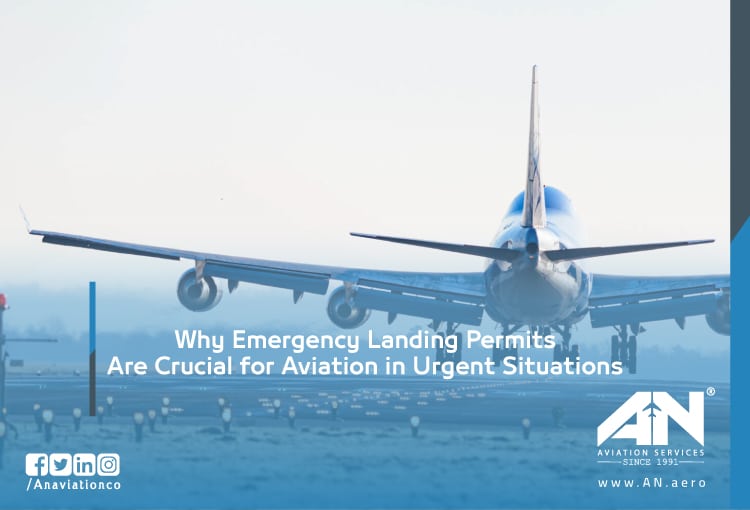
Emergencies can happen at any time in aviation, and when they do, the need for quick action is critical. That’s where emergency landing permits become useful. These permits are essential for any aircraft that has to land unexpectedly due to various issues and emergencies. Without them, pilots and operators can face major problems. Let’s break down these permits and why they’re so important for your flight safety and compliance.
What Are Emergency Landing Permits?
An emergency landing permit is exactly what it sounds like authorization to land at an airport when an urgent situation requires it. Whether it’s because of a mechanical issue, a medical emergency onboard, or dangerous weather conditions, these permits are necessary to ensure the aircraft can safely land at a nearby airport without any hassle.
These permits are a type of overflight and landing permit that allows aircraft operators to land on short notice. They ensure that everything runs smoothly and that the plane can get the attention it needs.
Why Emergency Landing Permits Matter for Safety and Compliance?
When it comes to aviation, safety is the top priority, and landing permits play a huge part in that. Emergency landing permits allow aircraft to land safely in situations where there’s an immediate threat. They also help operators stay in line with regulatory requirements from aviation authorities.
If an aircraft faces an emergency and can’t get approval to land right away, it puts everyone at risk. Having a clear process for obtaining emergency landing permits ensures that every flight can handle the unexpected without compromising safety or breaking any rules.
Typical Situations That Require Emergency Landing Permits:
- Mechanical Failures: If a plane has engine trouble or equipment stops working, the aircraft may need to land right away to prevent further issues.
- Medical Emergencies: Sometimes, a passenger or crew member requires immediate medical attention. An emergency landing permit helps get the plane on the ground quickly.
- Adverse Weather: Bad weather, like a sudden storm or poor visibility, could make it unsafe to continue the flight. In these cases, landing permits help the pilot find a safe airport.
The Role of Communication in Securing Emergency Landing Permits
Good communication is at the heart of getting an emergency landing permit. From the moment the emergency is identified, the aircraft operator must keep in constant contact with both the aviation authority and air traffic controllers. This communication ensures that everyone involved knows what’s happening, why the landing is necessary, and how soon it can happen.
This helps speed up the process, allowing the aircraft to land safely without waiting for long approvals. Quick, clear communication between the operator, air traffic control, and ground handling agents is key to ensuring everything goes as smoothly as possible during an emergency.
Regulatory Authorities and Their Roles
In Africa, civil aviation authorities (CAA) are in charge of making sure everything in the air runs smoothly, including emergency landings. These authorities, like the Civil Aviation Authority of South Africa, play a major role in regulating aviation safety, which includes emergency landing permits.
Their job is to ensure that any aircraft in need of landing follows the proper procedures. They also monitor flight paths and ensure that aircraft operators comply with all safety regulations.
How Civil Aviation Authorities in South and Middle Africa Handle Emergency Landing Permits?
In places like South and Middle Africa, the CAA works closely with local airports and air traffic controllers to manage emergency landing permits. These authorities ensure that aircraft operators follow the right steps and meet all the requirements when an emergency landing is needed.
They’ll also coordinate with local air traffic to get a plane safely on the ground, ensuring everything from air traffic control to landing fees is in place and managed.
Coordination with Local Authorities:
You can’t just land anywhere without approvals. Local airport authorities must be on the same page as the aircraft operator to ensure everything’s in order. Whether it’s dealing with air traffic or making sure the airport’s ready for an unscheduled landing, coordination is key.
Here’s how it typically works:
- Local Airport Approval: The pilot or aircraft commander contacts the air traffic controllers and the airport to request approval.
- Landing Slots: The airport must have space available for an emergency landing, especially if there’s a landing fee involved.
- Communication: Coordinating quickly with local authorities is vital for smooth operations.
The Process of Obtaining Emergency Landing Permits
So, how do you get one of these permits? Here’s what to expect:
- Initiating the Request: As soon as the emergency is identified, the aircraft operator needs to contact the aviation authority to request the permit.
- Provide Key Info: The operator must provide essential information like the flight plan, aircraft details, and the reason for the emergency.
- Submit Documentation: A flight operations team will also need to provide documentation about the emergency, including any medical or technical reports, if relevant.
- Coordinate with All Parties: The operator must stay in contact with the air traffic control team and ground handling agents to ensure everything is ready when the aircraft lands.
- Permit Approval: Once the permit is approved, the aviation authority sends it to the flight crew and all other parties involved.
How Ground Handling Agents and Flight Support Companies Play a Role?
At An Aviation Ground handling and flight support services help make the whole process smoother. They’ll assist with obtaining the emergency landing permit and ensure that all logistics at the airport, like refueling, catering, and airport landing procedures, are taken care of. They’ll also coordinate with civil aviation and other necessary authorities to get the aircraft back on track as soon as possible.
Emergency landing permits are essential for keeping aviation safe and compliant. Whether you’re an aircraft operator, a flight commander, or involved with flight operations, knowing how to obtain these permits and working with the right authorities is critical for handling unexpected situations. By understanding the process and being prepared, you’ll ensure the safety of your aircraft and everyone on board.

